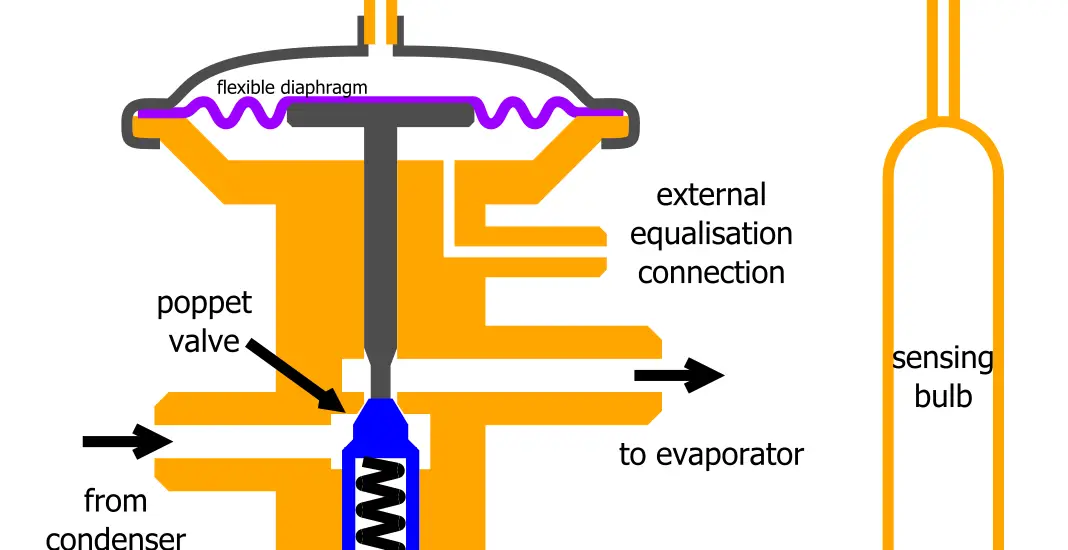In this article, we’ll be comparing TXV vs expansion valve. We’ll unravel the intricate details, describing the differences and similarities between TXV and expansion valves.

Table of Contents
What is TXV?
TXV stands for Thermostatic Expansion Valve. It is a precision device used to control the amount of refrigerant released into the evaporator. Understanding the ‘TXV vs expansion valve’ scenario begins with grasping the functioning of TXV.
It operates based on the temperature and the flow rate of the refrigerant, adjusting its pace to maintain a constant superheat at the evaporator outlet, which aids in efficient cooling.
What is an Expansion Valve?
An integral part of the ‘TXV vs expansion valve’ discussion is understanding what an expansion valve is. This type of valve is a bit broader term that encompasses several different valves including the TXV.
Expansion valves are essentially devices that regulate the flow of refrigerant into the evaporator, contributing to the cooling process. They come in different types, such as thermostatic, automatic, and electronic, each operating based on different principles.
TXV vs Expansion Valve: A Detailed Comparison
In the core of our ‘TXV vs expansion valve’ exploration, we come to the pivotal point where we define the nuances that differentiate these two entities. It’s vital to note that while all TXVs are expansion valves, not all expansion valves are TXVs.
Starting with TXVs, or Thermostatic Expansion Valves, they are renowned for their precision in regulating refrigerant flow. This is achieved through a sensing bulb filled with a gas that reacts to temperature changes in the environment, consequently adjusting the valve to maintain a predetermined superheat level at the evaporator outlet.
This functionality ensures a consistent and efficient operation, minimizing fluctuations and instabilities in the system.
On the flip side, when we speak of expansion valves in a general sense, we refer to a category that includes TXVs but also encompasses other valve types such as electronic and automatic expansion valves.
These valves might not offer the same level of precision as TXVs, but they have their own set of functionalities that can be more suited to different scenarios. For instance, electronic expansion valves are known for their compatibility with modern, smart systems, offering an enhanced level of control through electronic modulation.
In this ‘TXV vs expansion valve’ comparison, it’s also critical to mention the ease of installation and maintenance. TXVs require a more meticulous installation process to ensure the sensing bulb is correctly positioned.
In contrast, other expansion valve types might offer a more straightforward installation, albeit at the potential cost of efficiency.
Check out these other articles…
Expansion Work in Thermodynamics: A Comprehensive 411 Guide
Expansion Process in Thermodynamics: Comprehensive 411 Guide
What is Thermal Expansion: A Complete 101 Guide
How Does Thermal Expansion Work: A Comprehensive 411 Guide
TXV Valve vs Piston: A Comprehensive Comparison
Benefits and Downsides of Using TXV and Expansion Valves
As we delve deeper into the ‘TXV vs expansion valve’ discourse, it is incumbent upon us to shed light on the benefits and downsides of utilizing either of these options in a cooling system.
TXVs stand tall with a host of benefits including but not limited to, their ability to maintain a consistent superheat, thereby guaranteeing a stable and efficient system operation.
This precisely controlled operation can lead to a longer lifespan for your system as it operates under less stress compared to systems utilizing other types of valves.
However, TXVs are not devoid of downsides. Their intricate design necessitates a more complex installation process, potentially leading to higher initial setup costs.
In addition, they might require more frequent maintenance to ensure optimum functionality.
On the other hand, when we look at other types of expansion valves, we find that they generally offer a simpler design, which translates to easier and less costly installation.
Yet, this simplicity comes with a compromise on the level of control over the refrigerant flow, which could result in a less efficient system operation over time.
Furthermore, it is worth noting that different types of expansion valves can be more suited to specific applications. For instance, an electronic expansion valve might be the ideal choice for modern systems integrated with smart technologies, offering functionalities that go beyond the capabilities of a TXV.
In conclusion, the ‘TXV vs expansion valve’ discussion reveals a landscape where each option comes with its own set of benefits and drawbacks.
Your choice should align with the specific demands of your system, your budget, and the level of efficiency you are aiming to achieve.
